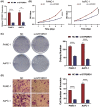GTF2IRD1 overexpression promotes tumor progression and correlates with less CD8+ T cells infiltration in pancreatic cancer
- PMID: 32936232
- PMCID: PMC7527428
- DOI: 10.1042/BSR20202150
GTF2IRD1 overexpression promotes tumor progression and correlates with less CD8+ T cells infiltration in pancreatic cancer
Abstract
Background: General Transcription Factor II-I Repeat Domain-Containing Protein 1 (GTF2IRD1) is a member of the GTF21 gene family, which encodes a set of multifunctional transcription factors. However, the potential function of GTF2IRD1 in pancreatic cancer (PC) still remains unknown. Study on GTF2IRD1 might provide a new insight into the carcinogenesis and therapeutics of PC.
Methods: In the current study, the clinical significance and potential biological of GTF2IRD1 were evaluated by bioinformatics analysis. The oncogenic role of GTF2IRD1 in PC was also determined using in vitro studies. Possible associations between GTF2IRD1 expression and tumor immunity were analyzed using ESTIMATE algorithm and single-sample Gene Set Enrichment Analysis (ssGSEA).
Results: GTF2IRD1 expression was significantly up-regulated in tumor tissues, and positively associated with higher histologic grade, higher American Joint Committee on Cancer (AJCC) stage, and worse prognosis. Function enrichment analysis demonstrated that GTF2IRD1 may be involved in pancreatic adenocarcinoma pathway, TGF-β signaling pathway, and tumor-infiltrating lymphocyte (TIL) related biological functions, such as T-cell receptor signaling pathway, leukocyte transendothelial migration, resistin as a regulator of inflammation, and regulation of leukocyte-mediated cytotoxicity. Knockdown of GTF2IRD1 expression inhibited cancer cell proliferation, colony formation, and invasion in vitro. ESTIMATE algorithm and ssGSEA demonstrated that GTF2IRD1 expression negatively correlated with the infiltration and anti-tumor activity of TILs, especially for CD8+ T cells.
Conclusion: The study demonstrates that GTF2IRD1 overexpression promotes tumor progression and correlates with less CD8+ T cells infiltration in PC.
Keywords: CD8+ T cells; GTF2IRD1; T cell receptor signaling pathway; TGF-β; pancreatic cancer.
© 2020 The Author(s).
Conflict of interest statement
The authors declare that there are no competing interests associated with the manuscript.
Figures




Similar articles
-
FAM83H overexpression predicts worse prognosis and correlates with less CD8+ T cells infiltration and Ras-PI3K-Akt-mTOR signaling pathway in pancreatic cancer.Clin Transl Oncol. 2020 Dec;22(12):2244-2252. doi: 10.1007/s12094-020-02365-z. Epub 2020 May 18. Clin Transl Oncol. 2020. PMID: 32424701
-
B3GNT3 overexpression promotes tumor progression and inhibits infiltration of CD8+ T cells in pancreatic cancer.Aging (Albany NY). 2020 Dec 9;13(2):2310-2329. doi: 10.18632/aging.202255. Epub 2020 Dec 9. Aging (Albany NY). 2020. PMID: 33316775 Free PMC article.
-
DKK2 Impairs Tumor Immunity Infiltration and Correlates with Poor Prognosis in Pancreatic Ductal Adenocarcinoma.J Immunol Res. 2019 Sep 8;2019:8656282. doi: 10.1155/2019/8656282. eCollection 2019. J Immunol Res. 2019. PMID: 31583260 Free PMC article.
-
The prognostic value of tumour-infiltrating lymphocytes in pancreatic cancer: a systematic review and meta-analysis.Eur J Cancer. 2020 Jun;132:71-84. doi: 10.1016/j.ejca.2020.03.013. Epub 2020 Apr 22. Eur J Cancer. 2020. PMID: 32334338
-
Diverse molecular functions of aspartate β‑hydroxylase in cancer (Review).Oncol Rep. 2020 Dec;44(6):2364-2372. doi: 10.3892/or.2020.7792. Epub 2020 Oct 6. Oncol Rep. 2020. PMID: 33125119 Free PMC article. Review.
Cited by
-
Insulin-like growth factor 2 receptor is a key immune-related gene that is correlated with a poor prognosis in patients with triple-negative breast cancer: A bioinformatics analysis.Front Oncol. 2022 Oct 18;12:871786. doi: 10.3389/fonc.2022.871786. eCollection 2022. Front Oncol. 2022. PMID: 36330486 Free PMC article.
-
Comprehensive Analysis of a Ferroptosis-Related lncRNA Signature for Predicting Prognosis and Immune Landscape in Osteosarcoma.Front Oncol. 2022 Jun 28;12:880459. doi: 10.3389/fonc.2022.880459. eCollection 2022. Front Oncol. 2022. PMID: 35837104 Free PMC article.
-
A cuproptosis-related lncRNAs signature predicts prognosis and reveals pivotal interactions between immune cells in colon cancer.Heliyon. 2024 Jul 14;10(14):e34586. doi: 10.1016/j.heliyon.2024.e34586. eCollection 2024 Jul 30. Heliyon. 2024. PMID: 39114018 Free PMC article.
-
Mechanisms of obesity- and diabetes mellitus-related pancreatic carcinogenesis: a comprehensive and systematic review.Signal Transduct Target Ther. 2023 Mar 24;8(1):139. doi: 10.1038/s41392-023-01376-w. Signal Transduct Target Ther. 2023. PMID: 36964133 Free PMC article.
-
Lymphocyte-Specific Biomarkers Associated With Preterm Birth and Bronchopulmonary Dysplasia.Front Immunol. 2021 Jan 21;11:563473. doi: 10.3389/fimmu.2020.563473. eCollection 2020. Front Immunol. 2021. PMID: 33552042 Free PMC article.
References
-
- Schouwenburg M.G., Suijkerbuijk K.P.M., Koornstra R.H.T., Jochems A., van Zeijl M.C.T., van den Eertwegh A.J.M. et al. . (2019) Switching to immune checkpoint inhibitors upon response to targeted therapy; the road to long-term survival in advanced melanoma patients with highly elevated serum LDH? Cancers (Basel) 11, 1940 10.3390/cancers11121940 - DOI - PMC - PubMed
Publication types
MeSH terms
Substances
LinkOut - more resources
Full Text Sources
Medical
Molecular Biology Databases
Research Materials

